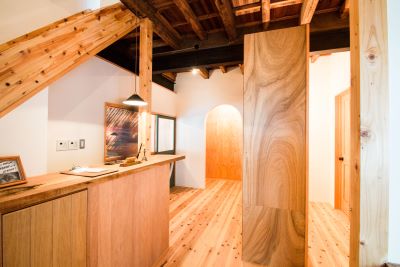
Pressure-treated wood can work indoors and outdoors; however, it’s not without controversy when used inside. Outside, pressure-treated wood has room to breathe and release all the toxic chemicals used to treat the wood. You do need to be safe with what pressure-treated wood you allow in your house. Let’s go over all the different factors to help you make a better decision for your household.
What is Pressure-treated Wood?
Pressure-treated wood is wood treated with chemicals and high pressure to make it resistant to a variety of problems. It’s capable of preserving the wood, preventing decay, infestation, mold, and water damage. The treatment can cause a green tint making it easy to identify but not as pretty for indoor use. Furthermore, the wood has chemicals inside you may not want in your home.
Why Choose Pressure-treated Wood for Indoor Use
Pressure-treated wood does not come with all the same problems as other wood. People who live in high humidity areas can avoid water-damaged or warped wood as pressure-treated wood can handle the elements better, making it an excellent option for use in bathrooms or rooms that retain a lot of moisture.
Many people use pressure-treated wood as a shower bench or a bathroom caddy as it can resist mold and protect against water damage. Also, you can use pressure-treated wood for sill plates to act as a barrier between a door and a wall, especially for an exterior door.
You can use pressure-treated wood for furniture, but if you plan to use it for a table, you will need to treat it with a protective coating and preferably with several coats.
When to Avoid Pressure-treated Wood Indoors
You should never use pressure-treated wood for items you will eat from, which eliminates their use for most kitchen surfaces. Do not use treated wood for tables, counters, cutting boards, or as dishes of any sort. Also, do not use pressure-treated wood for anything pets may chew on, like a pet bed, as this would pose a threat when chewed or eaten.
Benefits of Pressure-treated Wood
One of the main benefits of pressure-treated wood is the ability to withstand elements. Water and sunlight are not the only elements but also infestations from bugs, especially termites. Those nasty little creatures love to eat wood but refuse to dine on treated wood. People with allergies will love that the wood can prevent mold, too, as that’s a huge allergen.
Best Ways to Use Pressure-treated Wood Inside
If you do choose to use pressure-treated wood inside, use it in several ways, including flooring, wall paneling, framing, and as furniture. Because the wood can resist mold, water, and damage, it’s perfect for these larger areas to keep your home from falling apart! However, before using inside, you will want to treat wood with stains and even polyurethane to prevent issues.
Using wood around windows or pipes can help to prevent issues of mold, bugs, and water damage which could help to protect your home significantly.
Toxicity of Pressure-treated Wood
Pressure-treated wood can be toxic when used for food items, which is why you should avoid using it for most kitchen items. Most people are worried about leach or off-gassing from all the chemicals used to treat the wood, but this should not be a major concern.
In the past, manufacturers used something called chromated copper arsenate (CCA) to treat wood, and this was toxic as it contained arsenic. The Environmental Protection Agency banned the practice back in 2003, making it less of a danger without the arsenic. However, pressured wood uses alkaline copper quaternary (ACQ), sodium borate (SBX), and micronized copper quaternary (MCQ), which are harmless in comparison to the CCA.
To check the toxicity of the pressure-treated wood, read the label at the end of each board, as it should tell you what you will find in the wood. Avoid using wood used for ground contact as it contains more and stronger chemicals. Also, never use wood that was created for outdoor use and then transform it into a piece for indoor use, such as a vintage telephone pole.
You do not need to worry about wood releasing toxic fumes that will cause issues for your family. Keep in mind, though; it’s better to be safe than sorry, especially for someone with severe issues. Do not use pressure-treated wood in a nursery or a baby or child’s room, and also avoid using it in places with people who have severe allergies. Some people are more susceptible to chemicals than others, and if they have any issues, try removing any potential toxins to reduce the risks and issues.
Treating and Refinishing Pressure-treated Wood
The best bet when using pressure-treated wood indoors is to treat it to reduce any risk. Consider painting, staining, or using a protective coating like polyurethane or wax to reduce the risks. If you paint or stain, definitely use polyurethane or shellac over it too. Using water-based products further reduces toxins too. If you do not have issues with termites in your area or humidity issues, you probably do not need to use pressure-treated wood.
Furthermore, treated wood does not mean the wood has been sanded. It can cause wood slivers, and if these get into the skin, they can cause serious infections. For this reason, sand and treat any wood used indoors to prevent the chance of slivers and infections.
Final Thoughts
While the main toxin was removed from treated wood back in 2003, pressure-treated wood still has chemicals. Yes, you can use pressure-treated wood inside, but you need to be careful and keep it away from food, babies, children, and pets. Furthermore, you need to seal the wood and keep it away from people with allergy issues. Pressure-treated wood can be a great option as it resists mold, water damage, and infestations.